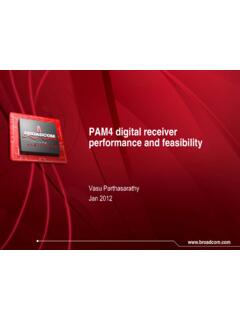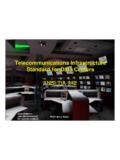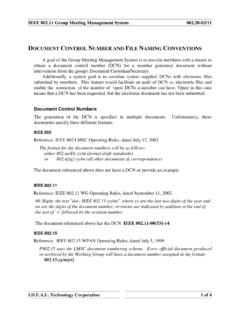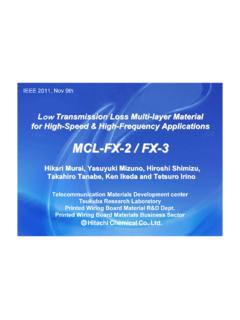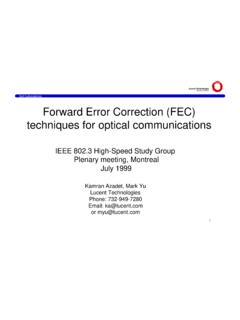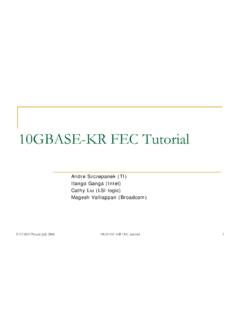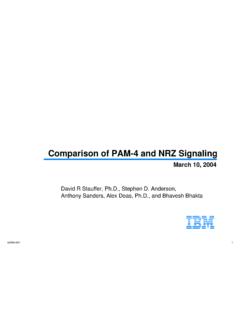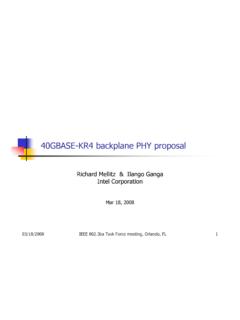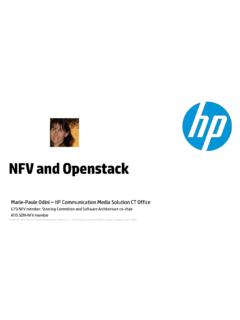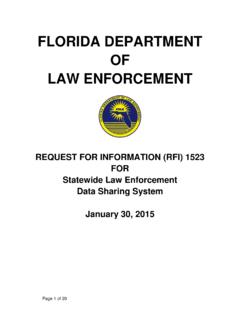Transcription of DETERMINISTIC ETHERNET - IEEE 802
1 DETERMINISTIC ETHERNETIEEE standards for real-time process control, industrial automation, and vehicular networksIEEE 802 tutorialNovember 12, 2012 DETERMINISTIC Ethernet2 Contents History, markets and use cases Time synchronization on networks Quality of Service Shortest Path Bridging Mixed-technology networking This presentation with animations is available at: 12, 2012 IEEE 802 tutorialDeterministic Ethernet3 HISTORY, MARKETS AND USE CASESO liver Kleineberg Belden / Hirschmann Automation & ControlDeterministic Ethernet4 History and Emerging Markets Early adopters outside IT: Industrial Automation (~1990s)Automation Pyramid Higher Bandwidth than Fieldbusses (legacy automation network technologies, Profibus, Interbus, ..) Convergence with IT services Widely available silicon could largely be re-used Micro-Segmentation / Fully switched networks introduced first DETERMINISTIC ETHERNET Easy fibre adoptionManufacturing shop floor History, markets and use casesDeterministic Ethernet5 History and Emerging Markets Early adopters outside IT: Professional and Home Audio and Video (early to mid 2000 s) High Performance Good Price / Performance High flexibility in wiring and media Easily merges with existing home entertainment networks and Wireless LANs In 2005, work in IEEE (Residential ETHERNET ) started Later moved to IEEE as Audio and Video BridgingHome Theater PC(*)Live Performances(*)Converged home networked services: File storage VoIP Audio and Video transmission(on demand)(*) Source: Wikipedia History, markets and use casesDeterministic Ethernet6 History and Emerging Markets Existing Technologies.
2 IEEE and Non-IEEE IEEE Audio and Video Bridging Of high interest in Professional and Home Audio and Video Time Synchronization based on well-proven IEEE 1588 protocol Bandwidth Reservation and Class-based QoS (Traffic Shaping) DETERMINISTIC Real-Time ETHERNET technology that fits the original use case very well Already applicable to some of the emerging new market applications IEEE Shortest Path Briding Providing resiliency to failures in the network infrastructure Where no IEEE standards were available, other specifications emerged, often driven by proprietary technologies: Proprietary protocols for Professional Audio ( Cobranet) Proprietary protocols for Industrial Automation ( ISO/IEC addressing Redundancy and Real-Time in ISO/IEC 62439 / 61158 / 61784 series) Application-specific extensions of standard IEEE 802 technologies ( ARINC Avionics Full-Duplex Switched ETHERNET - AFDX) High demand for aconverged IEEE 802 solution for DETERMINISTIC Ethernetto replace proprietary technology and fit the needs of existing and emerging markets.
3 History, markets and use casesDeterministic Ethernet7 History and Emerging Markets Emerging Markets: Mission-critical networking Emerges out of Industrial Automation, massively broadening the scope Requirements (far) beyond standard IT equipment relating to determinism in time and protocol behaviour Often used as transparent communication channel for End-to-End Safety Communication Risk for Life and Limb if the system fails High requirements to overall network, protocol and device robustnessPower Utility AutomationTraffic Control History, markets and use casesDeterministic Ethernet8 Use Case: Mission-critical Automation Railway: Rolling stock ETHERNET in trains has applications in customer information and also infotainment Another application area lies in train control networks and video ..as well as passenger counters and detectors on the automatic train doors History, markets and use casesDeterministic Ethernet9 Use Case: Motion ControlWind turbine: Synchronized rotor blade control actuatorsPrinting machine: Large number of synchronized axlesApplications where robots and humansclosely interact: Robot-assisted manufacturing Robot-assisted surgery Robotic prostheses.
4 History, markets and use casesDeterministic Ethernet10 History and Emerging Markets Emerging Markets: Vehicular Networks Reduced Wiring Harness Reduced weight and cabling costs Reduce overall costs by using standardized chips Reduce risks of binding to one silicon/solution vendor Unified solution for different application areas ( Infotainment, Power Train, Driver Assistance, ..) Picture Sources: IEEE RTPGE SG History, markets and use casesDeterministic Ethernet11 Use Case: Vehicular NetworkSource: IEEE AVB TG presentationOne possible application example of a future vehicular network History, markets and use casesDeterministic Ethernet12 History and Emerging Markets One Step further - Added Requirements for a converged IEEE solution for DETERMINISTIC ETHERNET : There are many requirements already covered by AVB and other IEEE 802 solutions, but the scope has broadened Need to support larger network structures (long daisy-chains, interconnected ) Very High EM resistance and low weight/cost of PHY s(see RTPGE) Very low latency and jitter, exceeding the original AVB scope Seamless fault-tolerance Resilient Time and are currently starting or have already started to address these market needs!
5 History, markets and use casesNovember 12, 2012 IEEE 802 tutorialDeterministic Ethernet13 TIME SYNCHRONIZATION ON NETWORKSM ichael D. Johas Teener, Broadcom CorporationDeterministic Ethernet14 Agenda Why do we care? Network time synch fundamentals IEEE What s next Time synchronization on networksDeterministic Ethernet15 Uses and Requirements Phase/frequency lock for ETHERNET emulation of SDH/SONET architecture must meet ITU specs Event coordination for control and testing industrial / test & measurement Synchronization between multiple media streams 1 microsecond max error in professional use Frequency base for time stamping of audio/video packets less than 100 ps jitter for uncompressed HD video Time synchronization on networksDeterministic Ethernet16 This Is Not Easy IT networks were designed to carry as much information as possible as reliably as possible Speed was important, efficiency was important, delay minimization was important Maintaining synchronization was only a secondary concern (at best)
6 All concept of time was lost in network specifications except for physical layers Delays in buffers and queues were not communicated or measured. There was no explicit way for an application to determine when an event occurred on a remote device without some kind of out-of-band support: WWV, GPS, 1 PPS (one pulse per second) cable, IRIG, etc. Time synchronization on networksDeterministic Ethernet17So, How Do We Do It? The key is the measurement of delay .. which can be done via a packet exchange such as done in NTP (Network Time Protocol) Time synchronization on networksnetworkClientServerclient msgserver msgOrigin Timestamp: t1 Receive Timestamp: t2 Transmit Timestamp: t3 Destination Timestamp: t4know: t1,t2,t3,t4round trip delay=((t4-t1)-(t3-t2))one-way delay is half of the round trip, but only if delays are symmetric A client can then use a time value transmitted by a server just by adding the delayDeterministic Ethernet18 The Magic Is the Time Stamp A timestamp is the value of some timer when a particular event occurs The more precise and DETERMINISTIC the event, the better In NTP, it s not well usually a kernel/driver software event as close to the hardware as possible, only millisecond accuracy To get better results, we use a physical layer event.
7 In ETHERNET , that s the start of packet, sub microsecond accuracy By communicating the value of timestamps at well-known events, we can correlate network actions with actual time. Time synchronization on networksDeterministic Ethernet19 Precision Time Protocol (PTP) IEEE 1588 standardized the use of physical layer timestampsto compute network delays and define synchronization events IEEE is a 1588 profile with fewer options, and extended physical layer options Components Time Distribution Link Delay Measurement Best Master Clock Selection Time synchronization on networksDeterministic Ethernet20 Two Step Messaging How do we communicate the time of the start of a packet that is being transmitted? Send that time in a later packet, the follow up , as the precise origin timestamp Time synchronization on networks It is possible to insert the timestamp into a transmit packet on the fly .. this is called one step messaging.
8 DETERMINISTIC Ethernet21 Time Correction in a Bridge Bridges Delays are now relatively constant, since they are just cable delays, without queues or buffers 1588 calls this a transparent clock , required in A correction field in the FollowUp is incremented by the upstream delay and the residence time (t3-t2) The correction field plus the precise origin timestamp plus the upstream delay is the correct time Time synchronization on networksDeterministic Ethernet22 Path Delay Processing Done infrequently since delays are stable Time synchronization on networksDeterministic Ethernet23 IEEE uses a subset andsuperset of IEEE 1588v2 Different methods for delay measurement for different L2 technologies (full duplex) is supported using a very specific profile of IEEE 1588 (EPON), , and generalized CSN s (coordinated shared networks) are supported by new specifications Includes performance specifications for bridges as time aware systems Uses accumulated neighbor rate ratio calculations to improve accuracy and speed up convergence Includes plug and play operation and startup Requires use of a very specific form of BMCA (Best Master Clock Algorithm) that bridges also use Time synchronization on networksDeterministic Architecture Time synchronization on networksmedia dependent(see clauses 11, 12, 13 and annex E)media dependent(see clauses 11, 12, 13 and annex E)Media-dependenttime-aware systementitiesMedia-dependenttime-aware systementitiesPHYMACLLCMSPHYMACPortSyncM DSiteSyncClockSlaveClockMasterTime-aware higher-layer application(see clause 9)LocalClockPortSyncSyncClockSlaveTimeMD SyncSendMDSyncReceivePortSyncSyncPortSyn cSyncPortSyncPortSyncSyncLLCMDMDSyncSend MDSyncReceiveMSMAC relay(see IEEE )
9 ISSISSD eterministic Ethernet25 Best Master Clock Selection All bridges announce the quality of their clock to their neighbors The best announcements are propagated Each bridge compares received announcements to their own clock quality Quality is comprised of (in decreasing order of importance): Priority (configurable) Multiple clock quality fields MAC address If superior announce messages are received that bridge ceases to announce and adopts the superior bridge as the grand master If the grand master dies and announce messages cease all bridges announce and a new grand master is quickly chosen Time synchronization on networksDeterministic Ethernet26 Next Steps ( ) Explicit support for one-step processing Backwards compatible to two-step Hot standby for backup GMs Multiple paths for clock propagation Clock path quality metric Time synchronization on networksNovember 12, 2012 IEEE 802 tutorialDeterministic Ethernet27 QUALITY OF SERVICEC hristian BoigerDeggendorf University of Applied SciencesDeterministic Ethernet28 Quality of Service The requirements on traffic are very different for various applications and types of data For some applications it is enough to have strict priority transmission selection and low utilization But for some types of traffic with high QoS demands it is not enough to be sent before the lower priority traffic And some of these applications need guaranteed QoS( guaranteed very low latency)
10 The old IEEE QoS mechanisms did not provide guarantees Quality of ServiceDeterministic Ethernet29 Guaranteed QoS An example for a type of traffic with high QoSrequirements are audio/video streams Some applications need guaranteed low latency for this type of data The network needs low latency (latency = buffers) Audio Video Bridging addresses this problem One part of the solution to achieve the requirements of audio/video streams is the combination of: Stream reservation (incl. bandwidth reservation) Traffic shaping Both parts are necessary, in order to provide a latency guarantee for this type of traffic Quality of ServiceDeterministic Ethernet30 Audio Video Bridging Audio Video Bridging (AVB) introduced new a type of traffic classes for audio/video streams SR class A SR class B SR class A traffic has the highest priority in the network The major goals of the AVB QoS features are to: Protect the best effort traffic from the SR class traffic Protect the SR class traffic from best effort traffic Protect the SR class traffic from itself Both AVB QoS mechanisms (stream reservation and traffic shaping) address these goals Quality of ServiceDeterministic Ethernet31 Stream Reservation The Stream Reservation Protocol (SRP).
